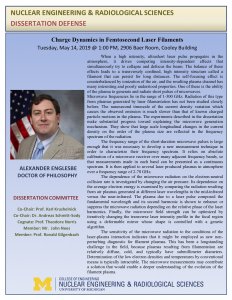Presented By: Nuclear Engineering & Radiological Sciences
PhD Defense: Alexander Englesbe
Charge Dynamics in Femtosecond Laser Filaments

Title: Charge Dynamics in Femtosecond Laser Filaments
Co-Chair: Prof. Karl Krushelnick
Co-Chair: Dr. Andreas Schmitt-Sody
Abstract: When a high intensity, ultrashort laser pulse propagates in the atmosphere, it drives competing intensity-dependent effects that simultaneously try to collapse and defocus the beam. The balance of these effects leads to a transversely confined, high intensity structure called a filament that can persist for long distances. The self-focusing effect is counterbalanced by ionization of the air, and the resulting plasma channel has many interesting and poorly understood properties. One of these is the ability of the plasma to generate and radiate short pulses of microwaves.
Microwave frequencies lie in the range of 1-300 GHz. Radiation of this type from plasmas generated by laser filamentation has not been studied closely before. The nanosecond timescale of the current density variation which causes the observed emission is much slower than that of known charged particle motions in the plasma. The experiments described in the dissertation make substantial progress toward explaining the microwave generation mechanism. They show that large scale longitudinal changes in the current density on the order of the plasma size are reflected in the frequency spectrum of the radiation.
The frequency range of the short-duration microwave pulses is large enough that it was necessary to develop a new measurement technique in order to characterize their frequency spectrum. It relies on absolute calibration of a microwave receiver over many adjacent frequency bands, so that measurements made in each band can be presented as a continuous spectrum. It is then applied to several laser produced plasmas in atmosphere over a frequency range of 2-70 GHz.
The dependence of the microwave radiation on the electron-neutral collision rate is investigated by changing the air pressure. Its dependence on the average electron energy is examined by comparing the radiation resulting from air plasmas generated at different laser wavelengths in the mid-infrared versus the near-infrared. The plasma due to a laser pulse composed the fundamental wavelength and its second harmonic is shown to enhance or suppress the microwave radiation depending on the relative phase of the laser harmonics. Finally, the microwave field strength can be optimized by iteratively changing the transverse laser intensity profile in the focal region using a deformable mirror whose shape is controlled with a genetic algorithm.
The sensitivity of the microwave radiation to the conditions of the laser-plasma interaction indicates that it might be employed as new non- perturbing diagnostic for filament plasmas. This has been a longstanding challenge in the field, because plasmas resulting from filamentation are relatively diffuse, cold, and typically have submillimeter diameters. Determination of the low electron densities and temperatures by conventional means is typically intractable. The microwave measurements may contribute a solution that would enable a deeper understanding of the evolution of the filament plasma.
Co-Chair: Prof. Karl Krushelnick
Co-Chair: Dr. Andreas Schmitt-Sody
Abstract: When a high intensity, ultrashort laser pulse propagates in the atmosphere, it drives competing intensity-dependent effects that simultaneously try to collapse and defocus the beam. The balance of these effects leads to a transversely confined, high intensity structure called a filament that can persist for long distances. The self-focusing effect is counterbalanced by ionization of the air, and the resulting plasma channel has many interesting and poorly understood properties. One of these is the ability of the plasma to generate and radiate short pulses of microwaves.
Microwave frequencies lie in the range of 1-300 GHz. Radiation of this type from plasmas generated by laser filamentation has not been studied closely before. The nanosecond timescale of the current density variation which causes the observed emission is much slower than that of known charged particle motions in the plasma. The experiments described in the dissertation make substantial progress toward explaining the microwave generation mechanism. They show that large scale longitudinal changes in the current density on the order of the plasma size are reflected in the frequency spectrum of the radiation.
The frequency range of the short-duration microwave pulses is large enough that it was necessary to develop a new measurement technique in order to characterize their frequency spectrum. It relies on absolute calibration of a microwave receiver over many adjacent frequency bands, so that measurements made in each band can be presented as a continuous spectrum. It is then applied to several laser produced plasmas in atmosphere over a frequency range of 2-70 GHz.
The dependence of the microwave radiation on the electron-neutral collision rate is investigated by changing the air pressure. Its dependence on the average electron energy is examined by comparing the radiation resulting from air plasmas generated at different laser wavelengths in the mid-infrared versus the near-infrared. The plasma due to a laser pulse composed the fundamental wavelength and its second harmonic is shown to enhance or suppress the microwave radiation depending on the relative phase of the laser harmonics. Finally, the microwave field strength can be optimized by iteratively changing the transverse laser intensity profile in the focal region using a deformable mirror whose shape is controlled with a genetic algorithm.
The sensitivity of the microwave radiation to the conditions of the laser-plasma interaction indicates that it might be employed as new non- perturbing diagnostic for filament plasmas. This has been a longstanding challenge in the field, because plasmas resulting from filamentation are relatively diffuse, cold, and typically have submillimeter diameters. Determination of the low electron densities and temperatures by conventional means is typically intractable. The microwave measurements may contribute a solution that would enable a deeper understanding of the evolution of the filament plasma.
Explore Similar Events
-
Loading Similar Events...
